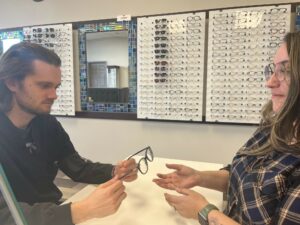
Opticians Dana Jagodzinski and Ben Collings at work in Dr. Gosling’s office. He says that HOYA’s iD LifeStyle® family of lenses do wonders for both patients’ quality of life and practice profitability.
Advanced lens technology that transforms the experience of progressive wearers with up to 3X lens peripheral deformations1.
Sponsored Content
By Thomas Gosling, OD
March 20, 2024
When a patient is prescribed a new progressive lens, there has traditionally been the concern of how well they would adapt. The next generation of progressive add lens from HOYA is about to greatly reduce these concerns for both ECPs and patients.
Adding 3D Binocular Vision Technology Makes All the Difference to Patient Adaption
For the visual system to be at its most comfortable state, binocularity should be maximized. HOYA’s binocular vision design philosophy used in iD LifeStyle® lenses creates the viewing experience as a lens pair, adjusting the power distribution in the reading corridor based off the right and left eye prescriptions functioning together. This allows for wider, more comfortable binocular teaming between the two eyes. This binocular balance between the two eyes produces a seamless and smooth adaptive process. This is especially noted when there is a difference (anisometropia) between the two eyes’ prescriptions, which is estimated to be almost 90 percent of the population2.
The larger the separation between the two eyes’ prescriptions, the greater the distortive effects or prism power shifts that occur. By considering each eye’s prescription, the binocular design of the lenses are clearly achieved; thus, enabling quick and easy adaptation. HOYA’s new 3D Binocular Vision™ technology helps enhance the existing Binocular Harmonization Technology™ (BHT). By using the Binocular Eye Model (BEM), the amount of peripheral deformation caused by prescription differences between the eyes is significantly reduced. As a result, when added to the vertical prism/power compensation of BHT, the lenses as a pair allow for ultimate adaptation and comfort in all directions of the near focal gaze.
Emphasis on How Well the Eyes Work Together
HOYA prioritizes creating a lens pair solution. This is especially important when the prescription between the two eyes is different. The larger the difference is between the eyes, the more significant HOYA’s binocular vision technologies become for lens-brain adaptation.
HOYA applies a Binocular Eye Model that uses ray tracing technology to create real-life scenarios for both eyes. The Binocular Eye Model considers all elements that are important for enhanced binocular performance of progressive lenses, and includes the patented Binocular Clearness Index, Binocular Accommodation Demand Difference, Binocular Vertical Prismatic Difference, Binocular Convergence and the Binocular Magnification Difference. These unique evaluation methods guarantee that each design is verified under real-life circumstances before it goes into production, and ensure unprecedented binocular performance of the lenses, regardless of the prescription difference of both eyes.
HOYA’s Binocular Harmonization Technology (BHT) considers the prescription for the right and left eyes as individual components to calculate the optimal binocular lens design, ensuring that the power distribution and progressive corridor of each lens is exact according to the needs of each eye. This results in perfect and effortless focusing, constant stability and excellent depth of vision.
3D Binocular Vision technology is an improvement over the unwanted prismatic effects between the right and left eye induced by the progressive add power distribution. This results in three times less peripheral deformation between two eyes1. Due to improvement of vertical and horizontal prism imbalance the user enjoys stable vision.
iD LifeStyle 4: Next generation of 3D Binocular Vision Progressive
When an eye looks through the optical center of a PAL lens, there should be no distorting effects created by peripheral astigmatic deformations. As the eye looks off the optical center into the periphery or down the reading corridor, the prismatic shift (Prentice’s Rule) causes the image to move and the prescription to shift.
By understanding, calculating and using complex algorithms, HOYA’s binocular lens technologies adjust the lens design to allow the two eyes to best work together both in the horizontal and vertical dimensions of each lens. This is what creates easy and consistent adaptation.
I prefer lenses with Binocular Vision Technology because this is what makes the brain happy. This is the lens design I usually go to first for my patients.
Opportunity to Add Value to Your Products & Services
It is important that patients understand the benefits, not just the features of the lenses you prescribe for them. To highlight the value of the iD Lifestyle 4, I might say to a patient:
“Progressive lens technologies will vary between manufacturers, and some lens designs can feel more comfortable to see through than others. The progressive lens design I am prescribing for you uses binocular technology that takes into consideration how both your eyes function together in your new prescription. This will allow the most accurate balance between your two eyes when looking near to far and side to side… giving you the best vision in all-around circumstances.”
The importance of having patients understand the benefits of utilizing the highest-quality lens designs begins by educating them in the exam lane. It’s a simple discussion about their daily visual demands and if they are experiencing struggles or symptoms of eye strain.
Discussing the benefits of a personalized lens design for each patient’s most significant visual demands is where I like to begin. That may be offering sunglasses for your outdoor worker or enthusiast, computer/work-style lenses for patients in front of screens more than six hours a day, or a top-quality progressive for the dynamic world of all-around vision.
Offering solutions to visual demands is an opportunity to enhance your patient’s lifestyle.
Upgrading the Patient Experience & Practice Brand
It is always important to stay on the leading edge of differentiation. My patients know they are getting the latest technology from me. This helps protect me from lower cost, commercial retail outlets and online sales.
HOYA lenses have always had a high adaptation rate and a low need for remakes. 3D Binocular Vision lens technology allows for the greatest chance of instant comfort and adaptation, stepping up where other brands have failed.
The brain loves binocularity, no matter what the visual task. As a combination, HOYA’s 3D Binocular Vision and Binocular Harmonization Technology, offered in the new iD LifeStyle 4 lens, will give the brain the greatest visual comfort in dynamic, static or fluctuant environments, bringing balanced vision at all demands.
Patients will find their new progressive lenses are as comfortable as their single-vision lenses and return to the doctor who made their transition into progressive lenses so easy.
1. Based on models of peripheral progressive deformation with and without 3D Binocular Vision™ technology.
2. Based on data collected from Sept 2020 till Sept 2022 in EMEA region.
 Thomas Gosling, OD, practices with Optical Matters in Littleton, Colo. To contact him: thomas.gosling@hoya.com
Thomas Gosling, OD, practices with Optical Matters in Littleton, Colo. To contact him: thomas.gosling@hoya.com

























